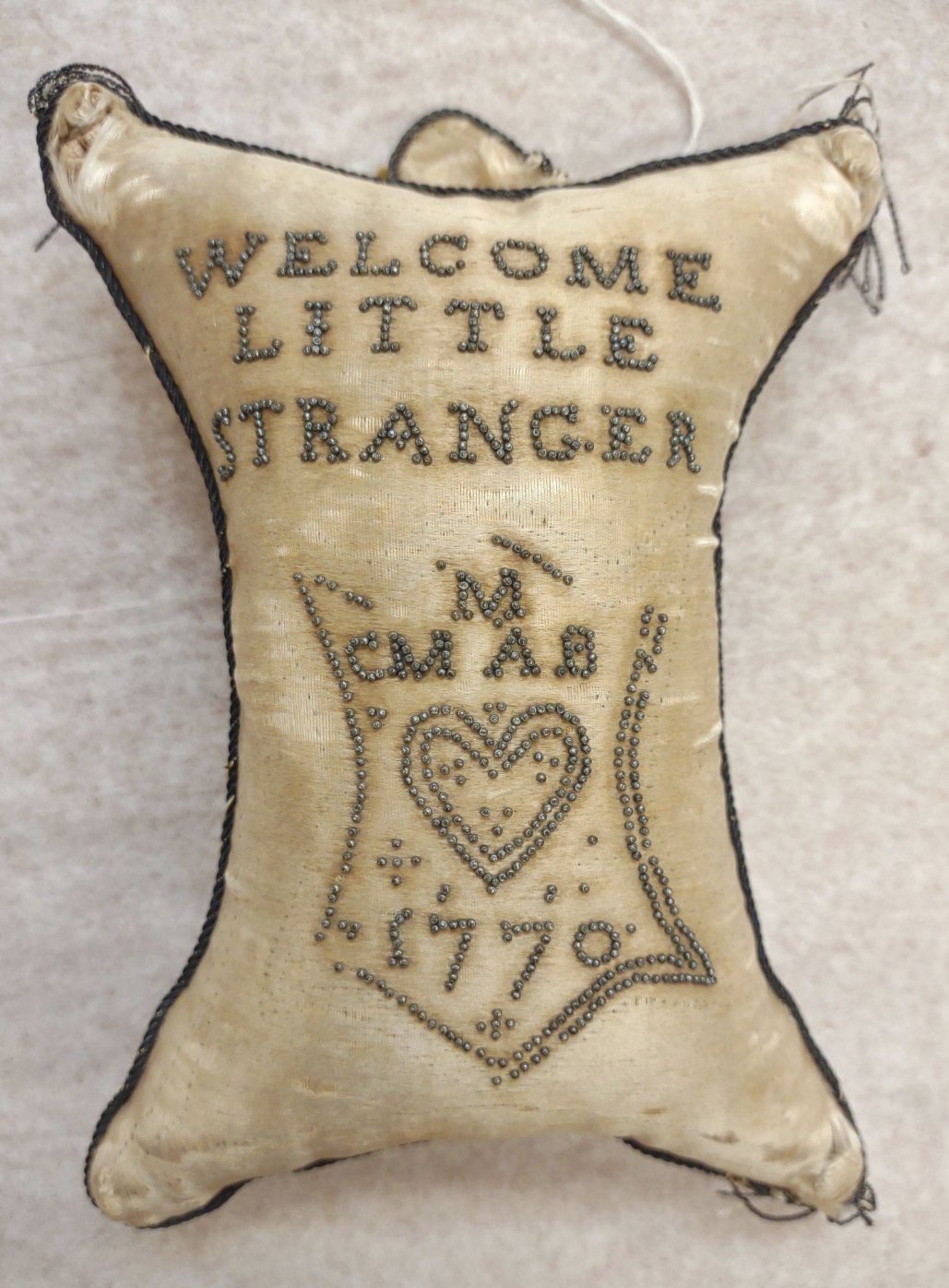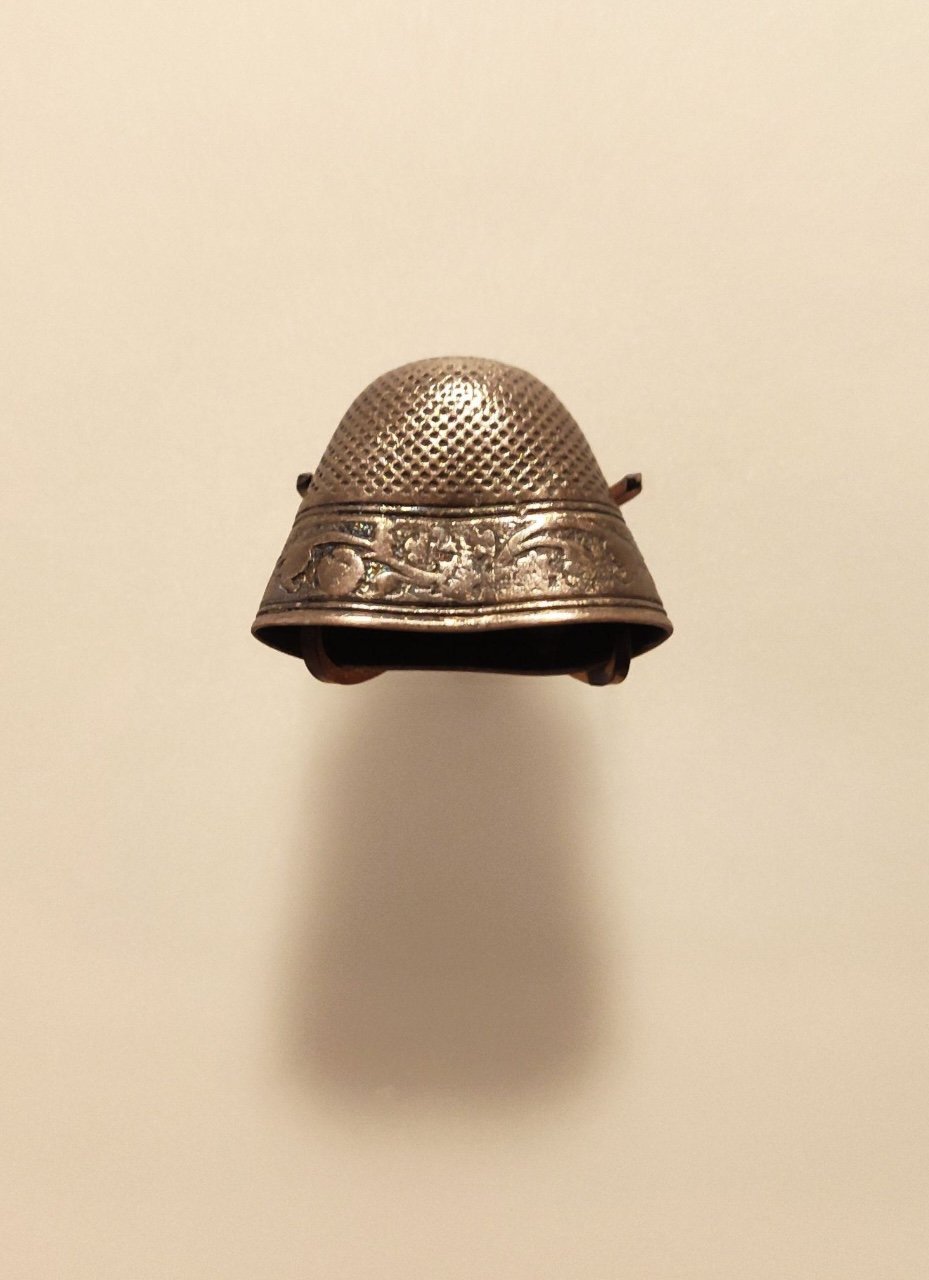Obsolescent Materialities of Motherhood
by Lauren Bradshaw
Layette pincushions retain valuable histories of 18th and 19th-century motherhood as these objects were gifted to new or expectant mothers and pins were used daily to fasten women’s clothing and secure babies’ diapers. Also referred to as christening pillows or maternity pincushions, their hopeful messages such as “Welcome Little Stranger,” took on anticipatory meaning as they would often be created before the birth of the child and entirely shift in meaning if either the mother or the child did not survive the birth, which was a common occurrence during this era. it.
Layette pincushion, Maker unknown, 1770, Stuffed silk & steel pins. Winterthur Museum, Garden, & Library, 1960.311.
Layette pincushion, Maker unknown, 1770, Stuffed silk & steel pins. Winterthur Museum, Garden, & Library, 1960.311.
As the messages and motifs are formed with pins, the aesthetic and sentimental value must be sacrificed by removing the pins in order to access their functionality as fastening devices. Some cushions were clearly utilized and are missing pins, while others were preserved for their commemoration. Superstitions surrounding birthing pains, such as “more pins, more pain,” led some women to remove all pins from the cushion if the gift was received before the birth.
1 Prior to mechanization in the early 19th century, pins were made individually by hand, which is significant to the specific visual characteristics of 18th-century layette pincushions. Similar styles with similar phrases continued to be made throughout the 19th century, but have a notably different appearance due to their mechanized, rather than wire-wrapped, pin heads.
Flattened thimble left with a child at the Foundling Hospital, 1759.
Scholars such as Sally Holloway, Chloe Wigston Smith, and Maria Zytaruk, have commented on the emotional weight of small objects as symbols of both sentiment and loss. 2 Zytaruk describes the ways in which foundling tokens, small identifiable objects left by mothers surrendering their infants to the Foundling Hospital during the 18th and 19th centuries, “materialize vividly the conditions of loss, absence, and dislocation that figured in many of the contexts of child abandonment.” (Zytaruk, 322) These objects include a variety of textile and needlework related items such as fragments of clothing, embroidery, or a thimble, and provide a stark counter-narrative based primarily on class status while still sharing the affective temporalities of textiles as a common ground.
Embroidery samplers were often a schoolgirl’s first introduction to needlework and these objects often recorded the many expected life transitions from girlhood to womanhood. Girls would begin with a simple marking or alphabet sampler, then move on to practical skills such as mending, and eventually samplers full of both verses and motifs. This type of practical work is referred to as “plain work”, and depending on the girl’s level of privilege, she would possibly move on to creating what is referred to as “fancy work”, such as needle lace. 3 While the majority of samplers were made by privileged white girls and women, there exist a small number of samplers made by Black girls and women that have been studied extensively by Kelli Racine Barnes 4, who states:
. . . needlework stitched by Black girls reveals how [they] were being groomed for womanhood in the midst of the formation of a white supremacist society grappling with the place of free and newly freed Black Americans demanding full citizenship rights. The idealized visions of white women and girls creating beautiful needlework within their homes and schools only tells part of the story of domestic work in the eighteenth and nineteenth century. (Barnes, 299)
Small embroidered bag left with a child at the Foundling Hospital, 18th c. Foundling Museum, London.
Entanglements of gender, race, and class are foundational to understanding the formation of idealized femininity in the 18th century. The socially constructed identity of “feminine” was reserved for those who exemplified the ideals of whiteness, ablebodiedness, high class status, and the ability to bear and raise children as well as perform domestic labor. In relation to gender binaries in Early America, Rachel Hope Cleves states:
Historians should treat the apparently nonambiguous categories of woman and man with equal caution . . . Moving beyond the binary means not only integrating evidence of gender and sex nonconforming individuals into our narratives of early America, but rethinking what we know about the normative organization of sexual difference. (Cleves, 463)
The harms of these foundations still permeate into the present as contemporary notions of womanhood remain in the eyes of many to be bound to childbirth and domesticity. Often passed down in families for generations, handcrafted objects strongly exemplify the ways in which notions of womanhood and motherhood were defined and deployed. Pincushions and other needlework objects trace the wide-ranging trajectories of maternal lineages through time and their complex narratives are still deeply embedded within contexts of contemporary craft and social history.
Bibliography
Auther, Elissa. String, Felt, Thread: The Hierarchy of Art and Craft in American Art. Minneapolis: University of Minnesota Press, 2010.
Barnes, Kelli Racine. “Schoolgirl Embroideries and Black Girlhood in Antebellum Philadelphia.” Journal of Textile Design Research and Practice 9 (3), 2021.
Beaudry, Mary Carolyn. Findings : The Material Culture of Needlework and Sewing. 1st ed. New Haven: Yale University Press, 2006.. https://doi.org/10.12987/9780300134803.
Bell, Nicholas R., ed. Nation Building: Craft and Contemporary American Culture. London: Bloomsbury, 2015.
Black, Anthea, and Nicole Burisch, eds. The New Politics of the Handmade: Craft, Art and Design. United Kingdom: Bloomsbury Publishing, 2020.
Bryan-Wilson, Julia. Fray : Art and Textile Politics. Chicago; The University of Chicago Press, 2017.
Cleves, Rachel Hope.. “Beyond the Binaries in Early America: Special Issue Introduction.” Early American Studies 12, no. 3 (2014): 459–68. http://www.jstor.org/stable/24474866.
Holloway, Sally. “Materializing Maternal Emotions: Birth, Celebration, and Renunciation in England, c.1688–1830,” in Feeling Things: Objects and Emotions through History, 2017. https://doi.org/10.1093/oso/9780198802648.003.0010.
Longman, Eleanor, and Sophy Loch. Pins and Pincushions. London: Longmans, Green and Co, 1911.
Parker, Rozsika. The Subversive Stitch: Embroidery and the Making of the Feminine. London: Women’s Press, 1984.
Ring, Betty. Girlhood Embroidery: American Samplers and Pictorial Needlework 1650-1850. New York: Alfred A. Knopf, 1993.
Smith, Chloe Wigston. Novels, Needleworks, and Empire: Material Entanglements in the Eighteenth-Century Atlantic World. 1st ed. New Haven: Yale University Press, 2024. https://doi.org/10.12987/9780300277722.
Swan, Susan Burrows. Plain & Fancy: American Women and Their Needlework, 1700-1850. First edition. New York: Holt, Rinehart and Winston, 1977.
Zytaruk, Maria. “Artifacts of Elegy: The Foundling Hospital Tokens.” Journal of British Studies 54, no. 2 (2015): 320–48. http://www.jstor.org/stable/24702041.




